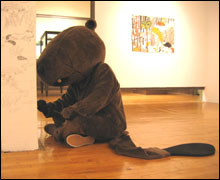 I’d been looking forward to Shintaro Miyake’s Beaver No Seikatsu (“Life of Beaver”) for weeks. For his first major show in the US, the 35-year-old Tokyo artist would create a pond filled with real water, a dam, beaver lodges, and drawings of beavers and kayakers. He’d present a beaver mockumentary. And for the first three days, he’d don a plush beaver get-up and draw on the walls. What could be cooler?
I’d been looking forward to Shintaro Miyake’s Beaver No Seikatsu (“Life of Beaver”) for weeks. For his first major show in the US, the 35-year-old Tokyo artist would create a pond filled with real water, a dam, beaver lodges, and drawings of beavers and kayakers. He’d present a beaver mockumentary. And for the first three days, he’d don a plush beaver get-up and draw on the walls. What could be cooler?
When I arrived at MassArt for the opening on February 7, the place was packed with art-student hipsters, some faculty, a cute short-haired girl wearing an “I ♥ beavers” T-shirt, a few Newbury Street nabobs, and a handful of parents and kids. The artist appeared in beaver garb and proceeded to scribble more beavers and kayakers on the support columns of the gallery as people crowded in to see. It was the kind of crowd where you unconsciously scan for exits. Clearly I was in the right place.
Miyake is the sort of artist who obsessively doodles cartoony girls on razor scooters, Star Wars heroes, pink Godzillas, bikini babes surfing atop jellyfish. His signature shtick is sketching on gallery walls or wandering the streets dressed as a plush rabbit, a round space alien, a kabuki actor, or a smiling pink-skinned blonde. In Italy, he jogged around the Colosseum dressed as a Minotaur and then “fought” a giant squid that bled helium-filled balloons.
He works in the international style a pal of mine has dubbed “Cute Brut.” Cute Brut adopts cute pop looks but cuts that cuteness with adult concerns and folkie or Art Brut techniques. The cuteness is a critique of traditional gender roles (i.e., real men don’t do cute), but these artists take it for granted that cartooning is a language that can take on any subject. Recent specimens around the city have included Brooklyn artist Misaki Kawai’s clunky paintings at Allston Skirt Gallery, the Paper Rad gang from East Hampton at Second Gallery (through March 10), and Boston artist Misa Saburi’s little wooden effigies at the Boston Center for the Arts (through March 19).
When I returned to MassArt a couple of days later, I found Beaver (Miyake in costume) still doodling on the gallery’s columns and a steady stream of people wandering in and out. One room had a pond filled with real water and stuffed beaver dolls perched on lodges. In a second room, a souvenir stand offered beaver trinkets, and an alcove featured actual beaver skeletons and pelts borrowed from Harvard. On the walls hung Miyake’s pencil and watercolor drawings of giant beavers gnawing bare trees and cavorting around lodges in ponds divided by dams made of upright sticks. Miniature houses appeared in the drawings, alone or clustered in dense villages. Smiling kayakers paddled about while freaked-out outdoorsmen howled from shore.